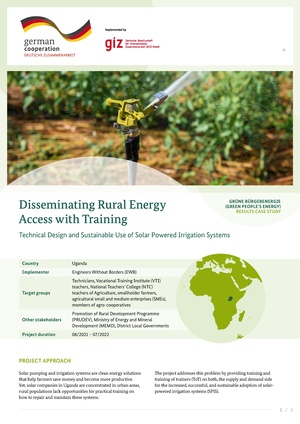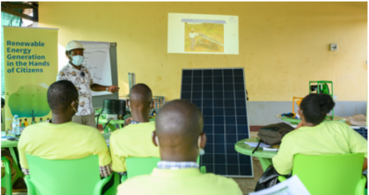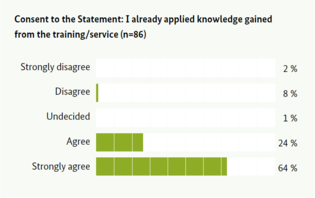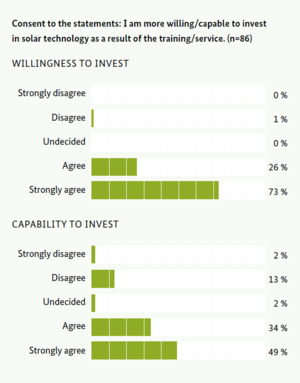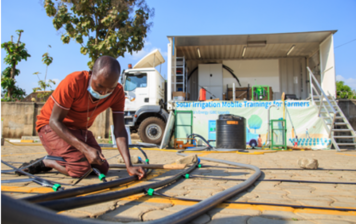Knowledge fuels change - Support energypedia!
For over 10 years, energypedia has been connecting energy experts around the world — helping them share knowledge, learn from each other, and accelerate the global energy transition.
Today, we ask for your support to keep this platform free and accessible to all.
Even a small contribution makes a big difference! If just 10–20% of our 60,000+ monthly visitors donated the equivalent of a cup of coffee — €5 — Energypedia would be fully funded for a whole year.
Is the knowledge you’ve gained through Energypedia this year worth €5 or more?
Your donation keeps the platform running, helps us create new knowledge products, and contributes directly to achieving SDG 7.
Thank you for your support, your donation, big or small, truly matters!
Disseminating Rural Energy Access with Training in Uganda
Disseminating Rural Energy Access with Training in Uganda
Project Approach
Solar pumping and irrigation systems are clean energy solutions that help farmers save money and become more productive. Yet, solar companies in Uganda are concentrated in urban areas, rural populations lack opportunities for practical training on how to repair and maintain these systems. The project addresses this problem by providing training and training of trainers (ToT) on both, the supply and demand side for the increased, successful, and sustainable adoption of solar-powered irrigation systems (SPIS).The supply-side training primarily targets 120 technicians in designing, installing, and maintaining such systems, as well as Vocational Training Institute (VTI) teachers and local government officials in the selected project areas. On the demand side, the training measures target 150 smallholder farmers, farmer groups, members of agro-cooperatives and agro-SMEs (agrarian small and medium-sized enterprises), as well as agricultural extension workers from local governments and non-governmental organisations (NGOs) who need to know how to operate and maintain SPIS in order to integrate them into extension activities with farmers. This training focuses on Operation and Maintenance (O&M) and practical exercises on how to efficiently integrate the new irrigation system (including responsible water use) into vegetable production and other agricultural activities to increase income. From both groups (supply and demand side), 30 participants are educated to become trainers, to ensure that the knowledge gained in the workshops is spread beyond the immediate beneficiaries and the duration of the Green People’s Energy project.
The project aims to achieve a minimum of 30 % female participation in the training activities and applies a gender-responsive training approach which considers the needs of both male and female participants. This includes deliberately selecting more female participants than the proportion of applicants (of whom there are significantly more men) would dictate. Female trainers are involved to encourage female participants to take bold steps to speak their minds or ask for clarification on best practice in solar powered irrigation. Childcare is also provided for female participants to enable participation of mothers who would otherwise not be able to take part. In addition, selected participants identified through a competitive call for expressions of interest and inclusive selection criteria, receive individualised advice on the feasibility of implementing SPIS on their farms and are provided with a technical system design and a respective financial analysis. For these participants, the Green People´s Energy project (Grüne Bürgerenergie, GBE) also offers financial support with a grant of 70 % of the system cost.
Methodology of Data Collection
The data for this case study report was collected through a review of project documents and five qualitative interviews, one jointly with representatives of the GBE project and Engineers Without Borders (EWB), and four interviews with farmers as end-users. Additionally, a quantitative survey was carried out among 151 farmers who received training, 15 of whom also received SPIS. 86 of the farmers (demand side) participated in the survey. The case study was conducted between April and May 2023.
Key Findings
Project Achievements
The project has trained a total of 283 participants, of whom 120 persons were on the supply side and 163 on the demand side. In both categories more than 30% are women. In addition, 40 farmers in the Lango, West Nile, and Acholi sub-regions received advisory services to assess the feasibility of using SPIS on their farms. The individual advisory service included a preliminary assessment of the farm site (e.g. suitability for irrigation, crop selection, water availability) and advice on a suitable SPIS (including cost estimate, quality standards, revenue projection, financing options, advice on crop water requirements and water conservation).
Detailed reports were produced on these topics for each participating farmer. Fifteen of these farmers installed SPIS as a result. 70 % of the system costs were subsidised by the GBE project for the installation of a drip irrigation system and the remaining 30 % were covered by the end users’ own contributions, which they needed to pay upfront.
Intermediate Impact
81 % of the farmers surveyed state that they had intended to use solar technology on their farms, already before the GBE intervention. However, after the training this number increased to 98 % (see figure 1). More importantly, 97 % of the respondents indicate that the training is highly relevant to their intention to use solar energy on their farms. The same percentage confirms that they have gained relevant knowledge about the technical functionality of solar systems. 88 % of the farmers surveyed report that they have already applied the knowledge gained from the training, mainly by irrigating their crops and starting to grow different types of vegetables (see figure 2). Others mention that they have brought light to their pig farms, have learned how to make liquid manure, or have started keeping records. Two of the farmers interviewed, who installed SPIS as a result of the intervention, report that their agricultural yields and their incomes have increased due to more regular irrigation. At the same time, they have been able to reduce their working hours, for example by not having to purchase diesel fuel anymore or carry out frequent repairs to diesel generators. The number of marketable crops grown has increased, with products such as tomatoes, watermelon, cabbage, green peppers, and aubergines.This is supported by the results of the quantitative survey. Another farmer reports that the number of farm workers needed per hectare has decreased due to the simplification of agricultural work in the field by replacing diesel pumps with SPIS. However, in some cases this effect is counteracted by the fact that farmers increase their agricultural land, which requires more labour for cultivation. Thus, there are opposing developments in terms of labour on farms using SPIS. Detailed monitoring of the overall impact on labour is therefore recommended for future cooperation projects.Based on the initial results of the training and introduction of SPIS, collaborations between farmers, NGOs, and local government institutions have been initiated. Students have participated in internships to learn about the technology, e.g. in several vocational schools in northern Uganda. Farmers who have received individual advisory support pass on their knowledge to their neighbours, thus acting as multipliers for the impact of the training. Other farmers come to learn from the experiences of the trained farmers and borrow the irrigation pumps, as has been reported by end-users in Gulu District.
Climate Impact
Following the calculation methodology of the United Nations Framework Convention on Climate Change (UNFCCC), the SPIS installations described above are estimated to mitigate 10.69 t CO2 e/a in the year of installation by avoiding and/or replacing the use of fossil fuels. This is roughly equivalent to the annual CO2 emissions of more than seven medium-sized cars in Germany.
Challenges in Project Implementation
While 99 % of the farmers surveyed state that they are more likely to invest in solar technology as a result of the intervention, financing these investments is a challenge. Although 83 % of the respondents believe they are able to invest in SPIS (see figure 3), only 17 % (15 out of 86) had actually purchased such a system at the time of the survey, and these were heavily subsidised by the GBE project, as mentioned above.
This indicates that users have difficulties in making upfront payments, even under a subsidy-scheme and require credits or rate- payment plans tailored to their needs and financial capabilities. With a total of 350 applicants for the trainings (including 151 farmers), demand far exceeded the capacity of the courses. Interest was particularly high from stakeholder institutions such as the district government, the Ministry of Energy and Mineral Development (MEMD), partner vocational institutes, solar companies, agricultural officers and finally the water, sanitation, and hygiene (WASH) sector. This high level of interest and diversity of participants is important for the sustainability of the project approach, because water is a vital and multi-stakeholder challenge, requiring the institutionalisation of knowledge and capacity. The high level of interest also indicates that future training offers will be well received.
Lessons Learned
SPIS have no operating cost, but during cloudy weather the solar water pump produces less energy and pumped water. Farmers must therefore be prepared to pump water into tanks and store it for the correct time and pressure for irrigation. The proper management not only requires awareness but also technical training, as provided by this project.The project provided practical trainings using an innovative mobile truck. This allowed irrigation tanks to be displayed, and practical exercises to be carried out on site, even in remote areas. Thereby more farmers could participate in the trainings as they do not have travel costs. Also, mobile trucks are more cost efficient compared to providing demos sites to several VTI.
An important aspect to keep in mind is the tendency of farmers to overuse water sources, as the operating costs of SPIS are very low compared to diesel pumps. The Ugandan government addresses this issue through awareness-raising campaigns. During the project’s technical trainings, technicians, teachers and district local government engineers were sensitised on incorporation of water meters for solar irrigation system designs and adoption of controllers or systems with embedded internet of things (IoT), to track a farm’s water usage and ensure proper water management during application of SPIS. In addition, the Water Users Association (WUA) and its expertise were involved in the project implementation to adapt water use to the specific sites. One major lesson is the use of drip irrigation to avoid water stress. Currently, several farmers who own SPIS are lending their pumps to other farmers in the neighbourhood for a fee. Such rental schemes can significantly contribute to increase interest and disseminate the technology. It also counterbalances the potential envy of non-participants in the project. In this context, active support for such rental schemes and their integration into cooperation projects can contribute to an increase of their impacts.Finally, projects aimed at raising awareness and increasing knowledge about the use of solar-powered irrigation systems will have limited impact and limited number of systems actually installed if barriers to financing are not addressed. Support for access to loan-based finance or the development of rate-payment solutions should therefore be provided in parallel.
Sustainability of the Intervention
The functioning of newly installed SPIS is initially ensured by the system suppliers, who offer a one-year after-sales guarantee. After this period, it is the responsibility of the farmers themselves to ensure that the SPIS keep working properly – the project took steps towards enabling them to do so and provide an initial kind of maintenance capacity. The positive impact of SPIS on the environment and climate in particular regarding pollution and CO2 emissions is observable. The project mitigated the risk of overuse of water as described above.Finally, the SPIS project has already developed a strong momentum of its own. Demonstration sites (e.g., in two vocational institutes, an institute of higher education, and a farmer group) have been set up to showcase SPIS on a permanent basis. They are attracting great interest. A SPIS demonstration club has also been formed at Gulu University as part of the gender approach. Its members receive garden fruits in return for maintaining the demonstration site. Local district government officials are trained by EWB in the operation and maintenance of SPIS, including SPIS best practices for vegetable farming. These advisors, agricultural engineers and water officials will continue to provide advisory services to farmers.
Conclusion and Outlook
The project has addressed a great need for knowledge and capacity in the use of solar energy in the agricultural sector in Uganda. It has increased the willingness of farmers to invest in solar technologies and nearly all participants found the training content highly relevant to their intention to use solar energy on their farms. Upscaling the project’s results has already begun, as farmers are sharing their knowledge and lending their SPIS to others, generating further interest in the use of solar energy. Institutional stakeholder, such as the German Raiffeisen Confederation are also interested in replicating similar training activities to promote SPIS in Uganda. Central and Western Uganda, with a more commercially viable agricultural production system, could be a suitable region for scaling up activities through similar interventions.

